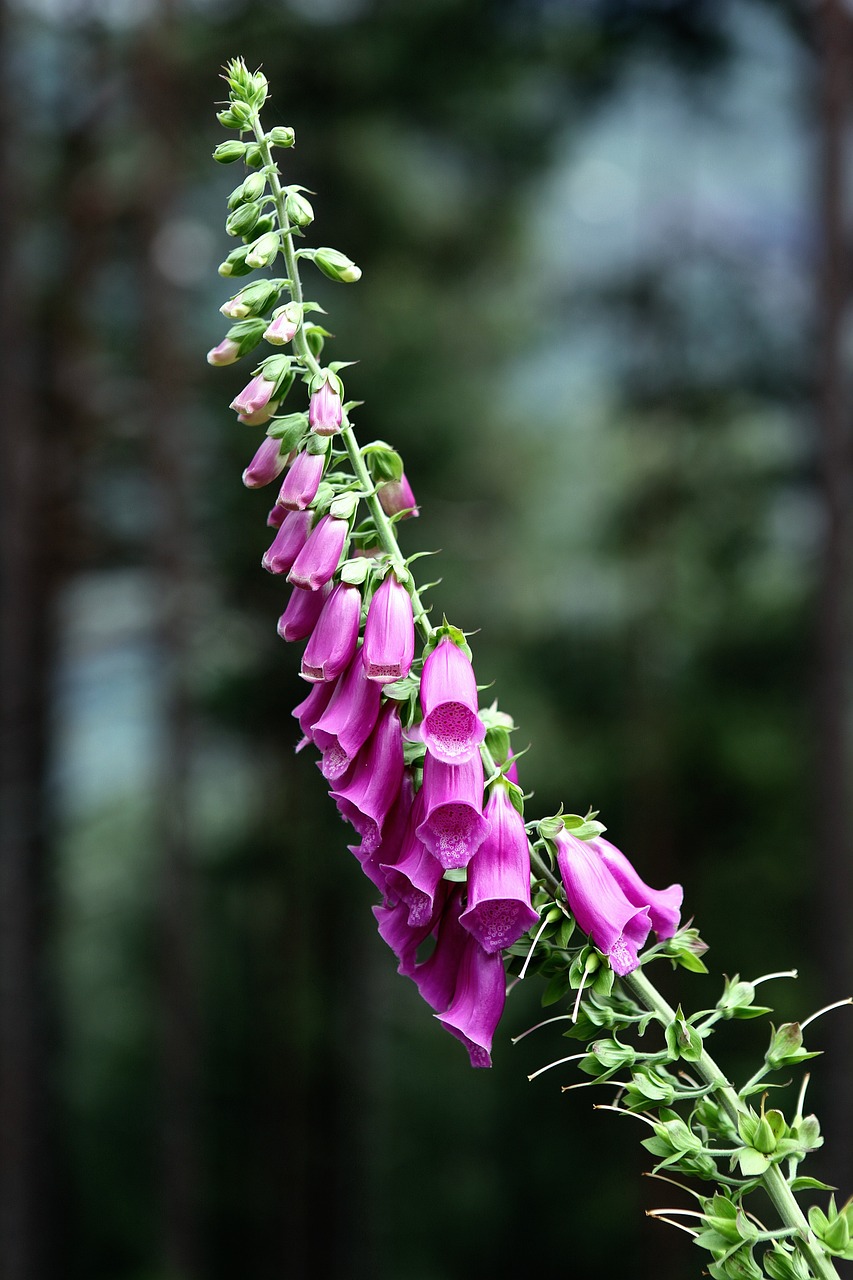Foxglove
Overview
The Foxglove (Digitalis spp.), adorned with elegant, bell-shaped flowers in various colors, is a popular choice in gardens. This biennial, part of the Plantaginaceae family, thrives in cooler, moist climates and slightly acidic soil. It is lauded for its ornamental value and its ability to attract beneficial pollinators while being resistant to deer and rabbits.

Characteristics
Known for its tall, elegant spikes of tubular, bell-shaped flowers in various colors, which attract pollinators and are resistant to deer and rabbits.
Region
Thrives in USDA zones 4 to 9, primarily in cool, moist climates.
Natural Habitat
Typically found in woodland clearings and occasionally in cottage gardens.
Cultivation
Thrives in partial shade, requires well-drained, slightly acidic soil, and needs consistent, moderate watering.
Uses and Benefits
The Foxglove plant, or Digitalis spp., is not only striking in appearance but also offers several practical benefits in gardening:
- Attracts pollinators: Its tall, colorful spikes are favored by hummingbirds and bumblebees, enhancing pollination in your garden.
- Deer and rabbit resistant: Foxglove’s natural resistance helps to keep these common garden pests at bay, ensuring your plants remain flourishing without the need for chemical repellents.
Overall, integrating Foxglove into your garden supports local wildlife and maintains a healthy, vibrant ecosystem with minimal maintenance.

Cultivation Tips
Cultivating Digitalis spp., commonly known as Foxglove, requires knowledge of its preferred conditions to thrive. This biennial plant, celebrated for its striking flower spikes, can enhance any garden with its ornamental qualities.
- Soil Quality: Begin with a soil test to adjust soil amendments accordingly. Foxgloves flourish in slightly acidic, well-drained soils.
- Climate Considerations: Ideal in USDA zones 4 to 9, Foxgloves prosper in cool, moist climates and should be shielded from extreme heat and humidity.
- Sunlight: They prefer partially shaded locations, particularly in warmer zones, to protect from afternoon sun.
- Watering: Regular watering helps maintain moisture around the roots, but avoid waterlogging.
- Planting: Sow seeds directly in the garden in late spring and expect blooms the following year. They form a rosette of leaves in their first year and bloom in the second.
By adhering to these guidelines, your Foxglove will not only be visually appealing but also a haven for local wildlife like hummingbirds and bumblebees1.
Companion Planting
Foxgloves (Digitalis spp.) excel in gardens that attract pollinators, making them suitable companions for other bee and hummingbird favorites. Consider planting them alongside lavender, echinacea, and salvia to create a vibrant pollinator-friendly zone.
These companions not only enhance each other’s beauty but also support a thriving ecosystem.1 4
Seasonal Considerations
Foxgloves, belonging to the genus Digitalis, thrive best in specific seasonal settings due to their preferences for cool, moist climates4. Here are the primary considerations for keeping your Foxgloves flourishing throughout the year:
- In spring, cooler temperatures support the initial growth spurt of Foxgloves, making it an ideal planting time.
- Summer care should focus on ensuring the soil remains moist and the plants are shaded from the harshest midday sun, especially in hotter regions.
- During the fall, Foxgloves continue to thrive, as the cooler temperatures and increased moisture levels create perfect growth conditions.
- Although relatively dormant in winter, in milder climates, they can continue to grow, albeit at a slower rate.
To fully appreciate the seasonal beauty of Foxgloves, timely planting and regular care according to these seasonal insights can lead to vibrant and healthy blooms throughout their growth cycle.

Issues and Troubleshooting
- Foxgloves are sensitive to overly wet conditions and poor drainage, which can lead to root rot 2. Ensuring soil is well-draining can prevent this issue.
- Hot and humid climates are not ideal for foxgloves, as they prefer cooler, moist environments 4. In warmer areas, providing some shade may help mitigate heat stress.
- Digitalis spp. can be susceptible to pests like aphids and slugs. Regular monitoring and natural deterrents or treatments can manage these pests effectively.
Implementing these measures greatly enhances the chance for healthy growth and vibrant blooms.
History and Folklore
Foxgloves, known scientifically as Digitalis spp., hold a place steeped in the warmth of traditional gardening and rich folklore. Historically, these iconic flowers have adorned woodland clearings and cottage gardens, creating a romantic landscape deeply rooted in European tradition3. Folklore often portrays foxgloves as magical plants. They are said to have the ability to ward off evil influences and protect homes. This mystical reputation is enhanced by their association with fairies, as legend has it that these whimsical beings are drawn to the bell-shaped blossoms where they can hide from prying eyes. These stories highlight foxgloves’ allure, intertwining nature with enchantment.
References
1. Foxglove: How to Plant and Grow Foxglove Flowers – The Old Farmer’s Almanac, https://www.almanac.com/plant/foxglove
2. Foxglove Care: Beginner’s Guide To Growing Foxglove – Gardening Know How, https://www.gardeningknowhow.com/ornamental/flowers/foxglove/foxglove-flowers.htm
3. How to grow foxgloves / RHS Gardening, https://www.rhs.org.uk/plants/foxglove/growing-guide
4. Foxglove: How to Grow and Care with Success – Gardenia, https://www.gardenia.net/guide/foxglove-how-to-grow-and-care-with-success
5. How to Plant and Grow Foxglove – Better Homes & Gardens, https://www.bhg.com/gardening/plant-dictionary/perennial/foxglove/
Image Credit: GabrieleLeonardy
Image Credit: Couleur
Image Credit: Vitamin
Nicolas Duval
Nicolas is a passionate advocate for nature and the art of wildcrafting. His dedication shines through in Wildcraftia, a website he meticulously crafted to serve as a haven for nature enthusiasts worldwide. Driven by a deep appreciation for nature’s connection to humanity, Nicolas embarked on his journey in 2011 with SmokableHerbs, a platform showcasing his love for nature’s bounty. Building upon this foundation, he established Smokably, a thriving online store offering premium herbs and blends to a global audience.
